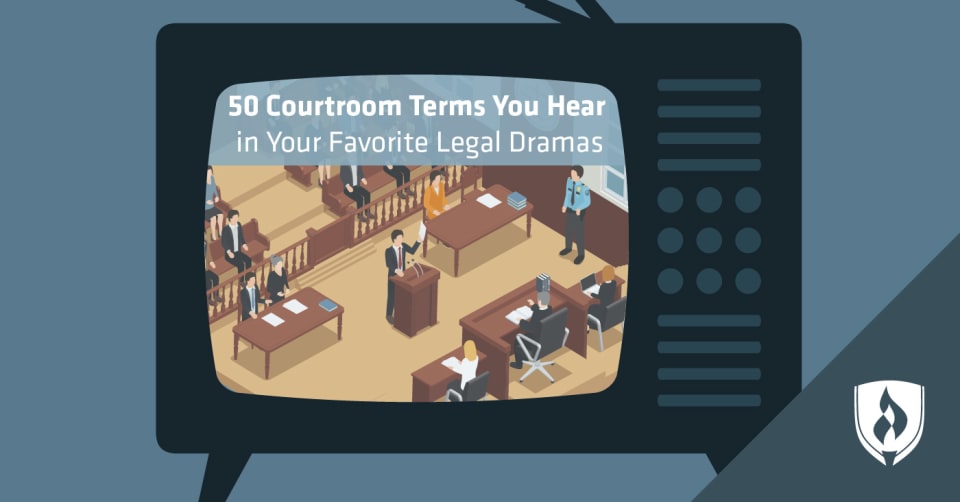
Courtroom drama—whether factual or fictional—is an undoubtedly riveting source of fascination for many. The narratives that stem from the courtroom provide a sort of window into some of the most complicated, yet foundational aspects of humanity: right vs. wrong, innocence vs. guilt, victim vs. criminal and, with some cases, past vs. present as they relate to the evolution of the law.
Whether you can’t seem to stop binge watching “The Good Wife,” are a member of the Olivia Benson and Elliot Stabler fan club or just love listening to each and every episode of the “Court Junkie” podcast on your favorite podcast app, you’re no stranger to the vernacular of the courtroom.
You may know your way around some of the more commonly used courtroom terms, such as testimony, objection, cross-examination, plea bargain and circumstantial evidence. But have you ever found yourself baffled by some of the legalese you hear in the episodes of your favorite court-based shows? Or maybe you suddenly realize that you don’t actually know the full meaning of some of the courtroom terms you’ve grown so accustomed to hearing.
If so, you’re certainly not alone. That’s why we rounded up some commonly used—and at times commonly misused—courtroom terms that everyone interested in the legal system should know.
50 Common courtroom terms you should know
Pre-trial legal terms
While the trial may be considered the main event to casual observers, true court enthusiasts know there’s a lot that needs to happen before we even make it to trial. From the gathering of evidence and interviewing of witnesses to the official laws and processes that must be followed, the following courtroom terms are ones you’ll typically hear in reference to the pre-trial period of a case.
Arraignment: The proceeding in which a defendant is brought to court, informed of the charges and asked to plead guilty or not guilty is called an arraignment.
Bench warrant: A bench warrant is a warrant issued by a judge commanding someone to appear in court based on their failure to obey a court order.
Cause of action: The cause of action refers to the reason for which a plaintiff has filed a complaint or suit against someone.
Deposition: A deposition is the testimony of a witness other than in open court—often in the form of an oral statement made before an officer who is authorized to administer oaths.
Discovery: All procedures used to obtain evidence prior to going to trial are considered discovery.
Extradition: An extradition is when one state surrenders an accused or convicted person to another state because the offense in reference was committed outside its own territory. The accused would then be extradited to the state in which the crime was allegedly committed.
Grand jury: A grand jury consists of 16–23 citizens who, upon listening to evidence presented by prosecutors, determine whether there is probable cause to believe the accused party committed an offense. The decision of a grand jury will determine if a case will be brought to trial.
Malfeasance: Put simply, malfeasance refers to an act being intentionally committed that is either legally or morally wrong.
Mens rea: A term that literally means “guilty mind” in Latin, mens rea is used to describe the criminal intent of an individual when committing a crime, otherwise known as criminal responsibility.
Pretrial hearing: After an arraignment has been completed, the defendant will return to court for a pretrial hearing. If the defendant pled “not guilty,” then the judge will use the pretrial hearing to set a date for the trial. Additionally, this hearing allows legal teams to challenge the permissibility of evidence, come to settlement agreements and discuss other important pretrial matters.
Recusal: A recusal is the voluntary action by a judge or prosecutor to remove themselves from presiding in a case. Recusals are often based on things like bias, conflict of interest or prejudice—for example, a state prosecutor may choose to recuse from a proceeding if the case is against their former employer. This is used to maintain a high standard for impartiality and fairness in the judicial system.
Subpoena vs. summons: While both entail a requirement for the recipient to appear in court, a subpoena is a process that directs a witness to give testimony or submit evidence, while a summons is a document that orders a person to appear before the court in response to a complaint. These are not mutually exclusive—you may be summoned to court and then subsequently subpoenaed by the court as it seeks out relevant evidence and information.
Legal terms about trials
Criminal court trials have been known to stretch on for months at a time. From opening to closing statements, a lot takes place that jury members (and viewers or listeners) must take in before transitioning to the deliberation and sentencing phases. The following courtroom terms may help you better understand the ins and outs of the next trial you tune into.
Affidavit: A term you’ve likely heard referenced often, an affidavit is simply a written or printed statement made under oath.
Bench trial vs. jury trial: While a jury trial is exactly what it sounds like—a traditional court trial in which the case’s outcome is decided by a jury of peers—a bench trial is a trial in which the judge fulfills the role of the jury. Most criminal cases in the U.S. are jury trials as it is a constitutional right under the Sixth Amendment.
Burden of proof: The burden of proof refers to the standard used to prove allegations in a court proceeding. The bar for this depends on the type of court proceeding. Criminal trials have a high burden of proof—the accused are presumed innocent until prosecutors can prove beyond a reasonable doubt that a crime was committed by the accused.
Case law: A term you may have heard casually tossed around in your favorite courtroom dramas, case law refers to the law as established in previous court decisions. Case law is a way of citing legal precedent.
Civil case vs. criminal case: The most commonly cited distinction between civil and criminal cases is that the latter are generally offenses against the state and are therefore prosecuted by the state. Conversely, civil cases are typically disputes between individuals adjudicated through civil lawsuits.
Perjury: A person commits the criminal offense of perjury when they make a false statement under oath about a matter that is material to the proceeding. It’s important to note that, while not recommended, it is still possible to make a false statement under oath without perjuring yourself if the statement is not relevant to the results of the proceeding. For instance, an actor can testify a falsehood about their age during a congressional hearing about the impact of violent media on children without committing a crime.
Probate: The process of administration of the estate of a dead person is referred to as probate. As such, the appropriate court for handling estate matters is called probate court.
Quash: A motion to quash essentially asks the judge to annul or set aside a specific action. For example, if the wrong person is served a summons to appear in court, an attorney may make a motion to quash.
Redirect: When a lawyer questions his or her own witness, it’s called a direct examination—after which, the opposing side has the opportunity to cross-examine the witness. Redirect examination refers to further questioning of a witness that can take place after cross-examination.
Sentencing & post-sentencing legal terms
After the closing arguments of a trial have commenced, the jury retreats to deliberate. Everything from that point on—from the verdict to the sentencing and into the post-sentencing phase—can greatly impact the lives of those involved—prosecution and defense alike.
Acquittal: An acquittal is when a jury determines that a criminal defendant is not guilty, or—in the case of a bench trial—when a judge finds that the evidence is insufficient to support a conviction.
Actual innocence: The term actual innocence refers to the absence of facts required for a conviction and is a common defense to criminal allegations. As part of a post-trial appeal using this defense, a defendant must submit additional evidence that undermines the court’s confidence in a guilty verdict.
Alford plea: When a defendant enters an Alford plea, they are not admitting guilt, but they are admitting that sufficient evidence exists to potentially obtain a conviction.
Appeal: After a defendant is found guilty, they can file an appeal—or a request that a higher court review the decision to determine if it was correct.
Assault vs. battery: Often mistakenly used interchangeably, assault and battery are distinct crimes. Assault is a lesser charge that refers to any intentional act that causes another party to fear they are about to suffer physical harm. Battery, however, requires that the aggressor physically strike or offensively touch the victim.
Clemency: Also referred to as executive clemency, clemency is the power a president possesses in federal criminal cases to offer a legal reprieve to a person convicted of a crime. Clemency powers include pardoning a convicted criminal, commuting their sentence or reducing it from, for example, the death penalty to a lesser sentence. Governors also have this power in state convictions.
Consecutive vs. concurrent: Determined by the judge during the sentencing phase, prison terms for two or more offenses can be served consecutively or concurrently. The former means the prison terms will be served one after the other, while the latter means the terms can be served at the same time.
Exoneration: An exoneration is when a charge, responsibility, duty or other blame imposed by law is removed.
Felony vs. misdemeanor: More serious than infractions like tickets and fines, a misdemeanor is usually defined as a crime that is punishable by up to a year in jail. Felonies, on the other hand, are the most serious types of crimes, typically punishable by prison sentences greater than one year.
First-degree murder vs. second-degree murder: While the definitions may vary slightly depending on the state, first-degree murder is typically defined as an unlawful killing that is both willful and premeditated. Second-degree murder, on the other hand, is generally defined as either an intentional killing that is not premeditated or a killing caused by dangerous conduct and the offender’s lack of concern for human life.
Habeas corpus: A writ of habeas corpus generally refers to a judicial order that forces law enforcement authorities to produce a prisoner in their custody and to thereby justify the prisoner’s continued incarceration.
Hung jury: When a jury is unable to reach a verdict, it’s considered a hung jury. When a trial ends this way, the case will then see a retrial with a new jury.
Ineffective assistance of counsel: Because the Supreme Court has held that part of the right to counsel is a right to effective assistance of counsel, ineffective assistance of counsel is a common habeas corpus claim. To prove ineffective assistance, a defendant must show that their lawyer’s performance fell “below an objective standard of reasonableness,” and that there is reason to believe that without counsel’s errors, the result of the trial would have been different.
Murder vs. manslaughter: It is thought that the difference between murder and manslaughter has everything to do with the killer’s state of mind—or mens rea. In a case of manslaughter, the offender is less culpable, since a killing is considered manslaughter when the defendant did not intend to kill but was grossly negligent. Murder, on the other hand, involves an intent to kill and also an intent to cause grievous bodily harm that actually caused death.
Prosecutorial misconduct: As its name implies, prosecutorial misconduct refers to conduct on behalf of a prosecutor that violates court rules or ethical standards of law practice. Examples of this include courtroom misconduct, tampering with evidence, failing to disclose evidence, threatening a witness and use of untruthful witnesses—all of which could be used to overturn a conviction when appealed.
Punitive damages: Damages awarded over and above compensatory damages in order to punish the defendant for their conduct are considered punitive damages. These are imposed to compensate for a plaintiff’s mental anguish, shame, degradation or other hardships beyond physical damages.
Restitution: When a defendant is ordered to provide either financial reimbursement to the victim or community service imposed by the court, this is considered restitution. Essentially, this is a payment of service or money to make up for what they’ve done.
Robbery vs. burglary: In the legal system, a robbery is considered a felonious taking of another’s property against their will by means of force or fear. Burglary doesn’t actually require that a theft occur—it is simply the unlawful entry into a home or business with the intent to commit a crime inside.
Statute of limitations: Many crimes can only be brought to trial within a certain time frame. The statute of limitations refers to the time within which a lawsuit must be filed or criminal prosecution begun.
Time served: When a judge is handing down a sentence and you hear them mention “time served,” this refers to the period a criminal defendant has been in jail while awaiting bail or trial, which can be substantial. When a judge gives a defendant credit for time served, this can play into their sentencing considerations.
Could you thrive in the courtroom?
Now that you’ve brushed up on 50 of the more common courtroom terms, you may begin to feel a little like you could hold your own before a judge and jury. If you’ve caught yourself daydreaming in between episodes of your favorite courtroom shows about what it would be like to work as a lawyer, it may be worth it to really pursue the question that’s gnawing at you: What is it really like to work in the legal system?
You can learn more about whether a career as a lawyer really is all you’ve been daydreaming about, or if a path toward a different legal career could be right for you by checking out our article, “Is Being a Lawyer Worth It? 5 Things to Consider About ‘America’s Unhappiest Job’.”
Related Articles:
- Keep Kids Safe: 6 Ways You're Unknowingly Endangering Your Child
- Life After Prison: 4 Barriers to Societal Reentry that Come with a Felony Conviction
- What Is the Criminal Justice System? A Closer Look at Its 3 Pillars




